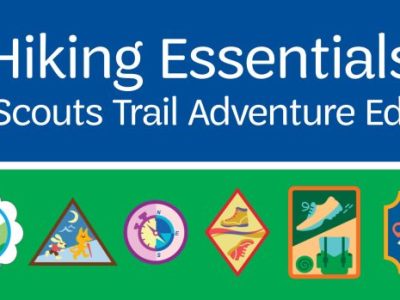Climbing and rappelling gear for scouts – For scouts embarking on adventures that involve climbing and rappelling, having the right gear is paramount. This comprehensive guide delves into the essential equipment, materials, and safety considerations for scouts to ensure their expeditions are both thrilling and secure.
Climbing and rappelling involve navigating vertical terrains, requiring specialized equipment for safety and efficiency. This guide explores the types of ropes, harnesses, carabiners, helmets, and belay devices used in climbing, along with their proper use and maintenance.
Climbing Equipment for Scouts

Scouts embarking on climbing adventures require specialized equipment to ensure safety and enhance their experience. This essential gear encompasses ropes, harnesses, carabiners, helmets, and belay devices, each meticulously designed to serve a specific purpose.
Ropes
Climbing ropes, typically made of nylon or a blend of nylon and other fibers, provide a secure lifeline during ascents and descents. Their strength and flexibility are crucial, and scouts must understand the proper handling and care of these ropes to prevent damage and ensure their reliability.
Harnesses
Harnesses, worn around the waist and legs, distribute the weight of the climber evenly, preventing injury in the event of a fall. Constructed from durable materials like nylon webbing or polyester, harnesses come in various sizes to fit scouts comfortably and securely.
Carabiners
Carabiners, lightweight metal clips with spring-loaded gates, serve as connectors between ropes, harnesses, and anchors. They are made from aluminum or steel alloys, ensuring strength and resistance to corrosion. Proper locking techniques are essential to prevent accidental opening.
Helmets
Helmets, crucial for protecting the head from falling objects or impacts, are a mandatory safety gear for climbers. Constructed from lightweight materials like plastic or foam, helmets absorb and disperse impact energy, reducing the risk of head injuries.
Belay Devices
Belay devices, attached to the climber’s harness, control the rope during ascents and descents, providing friction to prevent uncontrolled falls. Various types of belay devices exist, each with specific features and benefits, and scouts must be trained in their proper use and handling.
Rappelling Gear for Scouts
/IndependenceMonument298_33-571f97d95f9b58857d243f7e.jpg?w=700)
Rappelling is an exciting and challenging activity that requires specialized gear to ensure safety. Scouts embarking on rappelling adventures should be equipped with the following essential gear:
Ropes
Rappelling ropes are the lifeline of the rappeller. They must be strong, durable, and resistant to abrasion. Scouts should use kernmantle ropes, which have a nylon sheath over a nylon core. The sheath protects the core from damage, while the core provides strength.
Rappelling ropes come in various diameters, with 10.5mm being the most common for scouts.
Descenders
Descenders are mechanical devices that control the speed of descent on the rope. Scouts typically use either a figure-eight descender or an assisted braking descender (ABD). Figure-eight descenders are simple and inexpensive, but they require more skill to use safely.
ABDs are more user-friendly and provide additional safety features, making them a good choice for beginners.
Harnesses
Harnesses distribute the weight of the rappeller across the hips and legs, preventing injury in the event of a fall. Scouts should use full-body harnesses that are specifically designed for rappelling. The harness should fit snugly but not be too tight.
It should have adjustable leg loops and a padded waist belt for comfort.
Helmets
Helmets protect the rappeller’s head from falling rocks or other debris. Scouts should use helmets that are certified by the American National Standards Institute (ANSI) for climbing. The helmet should fit snugly and have a chin strap to keep it in place.
Gloves, Climbing and rappelling gear for scouts
Gloves protect the rappeller’s hands from rope burns and other injuries. Scouts should use gloves that are made of durable material and fit snugly. The gloves should have a good grip and allow for dexterity.
Selecting Gear for Different Scouting Activities: Climbing And Rappelling Gear For Scouts

Selecting the appropriate climbing and rappelling gear is crucial for the safety and enjoyment of scouting activities. Different activities, such as rock climbing, rappelling, and caving, require specific gear tailored to the unique challenges and demands of each environment.
Factors to consider when choosing gear include the level of difficulty of the activity, the environmental conditions, and the size of the group. It is essential to carefully assess these factors and select gear that is suitable for the intended use and skill level of the participants.
Rock Climbing
For rock climbing, essential gear includes a climbing harness, helmet, climbing shoes, and a belay device. The harness provides a secure anchor point for the climber, while the helmet protects the head from falling debris or impacts. Climbing shoes offer specialized grip and support for navigating different types of rock surfaces.
A belay device, such as an ATC or Grigri, is used to control the climber’s descent and ensure safety during rappelling.
Rappelling
Rappelling requires gear specifically designed for descending vertical surfaces. In addition to a climbing harness and helmet, rappellers use a rappel device, such as a figure-eight or a tube-style device, to control their descent. Rappel gloves protect the hands from friction and heat generated during the rappelling process.
A rappel backup, such as a Prusik knot or an auto-blocking device, provides an additional layer of safety by preventing uncontrolled falls.
Caving
Caving involves exploring underground environments and requires specialized gear for safety and comfort. In addition to a climbing harness and helmet, cavers use a headlamp to illuminate dark passages. Caving suits provide protection from abrasions and water, while knee pads and elbow pads offer cushioning and support in tight and confined spaces.
Gloves are essential for grip and protection from sharp rocks and debris.
Gear Maintenance and Inspection

Regular gear maintenance and inspection are crucial for the safety and longevity of climbing and rappelling equipment. It helps identify potential hazards and ensures gear is in optimal condition for use.
Inspecting and Maintaining Ropes
- Inspect ropes for cuts, fraying, flat spots, or glazing.
- Check rope ends for damage or fraying.
- Clean ropes with a mild detergent and dry thoroughly.
- Store ropes in a cool, dry place away from direct sunlight.
Inspecting and Maintaining Harnesses
- Inspect harnesses for any tears, cuts, or fraying in the webbing.
- Check buckles and adjustment points for smooth operation.
- Clean harnesses with a mild detergent and dry thoroughly.
- Store harnesses in a cool, dry place.
Inspecting and Maintaining Carabiners
- Inspect carabiners for cracks, nicks, or deformation.
- Check gate springs for proper operation.
- Clean carabiners with a mild detergent and dry thoroughly.
- Store carabiners in a cool, dry place.
Safety Considerations

Safety is paramount when engaging in climbing and rappelling activities. The inherent risks demand a stringent adherence to safety protocols to minimize potential hazards.
Prior to any ascent or descent, a thorough risk assessment is crucial. This involves evaluating the terrain, weather conditions, and equipment. Proper supervision by qualified instructors or experienced climbers is mandatory.
Emergency Procedures
Emergency preparedness is vital. All participants should be familiar with emergency procedures, including rescue techniques and first aid. A communication plan should be established to facilitate rapid response in case of an incident.
Equipment Inspection
Regular equipment inspection is essential to ensure its reliability. Inspect ropes, harnesses, carabiners, and other gear for any signs of damage or wear. Replace worn or damaged equipment immediately.
Safe Practices
Safe practices include wearing a helmet, using proper belay techniques, and maintaining a three-point contact system while climbing. Rappelling requires the use of a descender device and a friction hitch to control the descent rate. Proper training and practice are essential to master these techniques.
Wrap-Up

Equipping scouts with the appropriate climbing and rappelling gear empowers them to safely explore vertical environments. By understanding the equipment’s functions, materials, and maintenance requirements, scouts can confidently tackle challenges and enhance their outdoor experiences.
Essential FAQs
What are the key safety considerations for climbing and rappelling?
Proper supervision, risk assessment, emergency procedures, and adhering to safety guidelines are crucial for minimizing hazards.
How often should climbing and rappelling gear be inspected?
Regular inspections are essential to identify wear and damage. Ropes, harnesses, and carabiners should be inspected before each use.
What factors influence the selection of climbing and rappelling gear?
The level of difficulty, environmental conditions, and group size should be considered when choosing appropriate gear.





